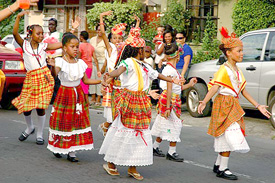Dominica culture food people and festivals
Dominica draws on a mix of cultures. Names ofFrench places appear as often as English. Africanlanguage, foods and customs often mingle with European traditions as part of the island's Creoleculture. The Caribs still carve dugouts (canoes), build houses on stilts, and weave distinctive basketwork.
Festivals and Music
Like most Caribbean islands, Dominica is home to several important festivals that center around music. Music of every kind can be found on the island, but calypso, reggae, and local folk music are particularly important.
Maps
Each village on the island has its own village feast, which is a celebration of that village. Village feasts happen throughout the year around the island, but Carnival is an island-wide festival that takes place throughout the Caribbean.
Dominica's Carnival celebration is known as Mas Dominik. It occurs before Lent and involves a "jump-up" celebration, as well as street parades and, of course, music. Wild costumes and calypso music are entertaining pieces of the celebration.
Geologically speaking, Dominica is one of the youngest islands in the Caribbean chain. It is a spry 26 million years old, still actively evolving with continuous geothermal activity.
Dominica's first inhabitants, the Ortoroids, arrived from South America around 3100 B.C., and lasted on the island until around 400 B.C. Next came the Arawaks, who settled in about 400 A.D. By 1400, the Kalinago or "Caribs," moved aggressively up the Caribbean from South America, eliminating the Arawak from the region, including Dominica. When Columbus ushered in the era of colonization to Dominica in 1493, the same fate that befell the Arawaks would threaten the Caribs.
Ignoring the Kalinago name of "Waitukubuli," Columbus renamed the island Dominica as he first made landfall on a Sunday. The Caribs successfully resisted efforts of Spanish colonization, but the British and French followed from the 1600s on, battling each other, and the Caribs, to claim the Island. Through the many battles and ravaged by disease, the Caribs gradually lost control of the island, fleeing back to South America. However, today approximately 2,000 Caribs remain on the island, most living in the Carib Territory in northeast Dominica. You many note that many of village names in and around Dominica are a mix of Carib, French and English, reflecting the power struggles of the last 500 years



















No comments:
Post a Comment